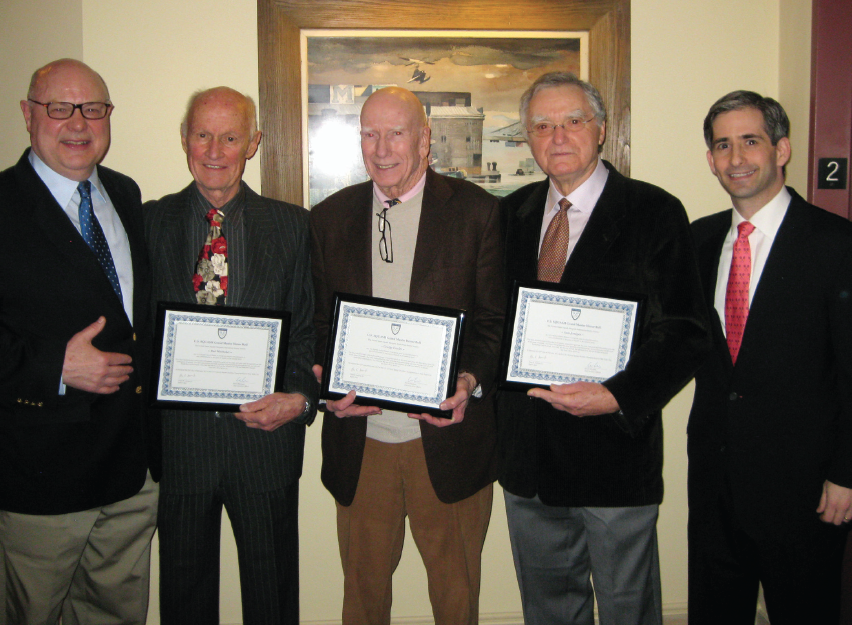
By James Zug
The 5th annual U.S. Squash Century Doubles Championships were held in New York in February 2011. Kit Tatum again hosted the tournament at the University Club, with additional play at CityView, New York Athletic, Racquet & Tennis and Union Clubs.
Tatum grew up in Toronto and learned his squash at the Granite Club. He moved to New York in 1971 and after eight years playing at the Downtown Athletic Club he joined the University. He’s been playing there ever since (partnering in doubles with George Kellner), except for a five-year stint in the eighties in Louisville.
The century as a doubles tournament platform—the two partners having a combined age of at least 100—has been around for decades. Tennis and paddle tennis both have them. The University Club has long had an intra-club century squash tournament and its member-guest, the Silver Fox, has a century, as had the Bigelow Cup (Union v. R&T v. U Club). Even the U.S. Father & Son started a century in 2006.
“I saw a national century championship as an event that could bridge the many generations who enjoy the game, and bring them together for a relaxing and fun weekend,” Tatum said about the origins of the tournament in 2007. “A century draw forces everyone to reach out and to play with a new set of partners, and to always be on the look-out for a younger legs. It is meant to be less intense than the other national championships, and have an equal measure of socializing with your squash friends from over the years. Throw in a keg of beer, and you’ve got yourself a fun event.”
This tournament has spawned a number of others: a Canadian version was started ten months after the inaugural U.S. one and now a number of clubs around the country have a century club championships.
As Tatum suggested, the highlight of the weekend was the Saturday evening party, held in the second-floor tap room of the U Club. Three men were given the Grand Master award, now in its second year: Sam Jernigan (Newport), George Fowler (St. Louis) and Bud Whitaker (Toronto). Kevin and Kenton Jernigan introduced their father; Clark Amos introduced Fowler and Doug Whittaker introduced his father. The award goes to senior statesmen in our game who are the unsung, behind-the-scenes types, the ones who love the game and travel often and have continued to play and be involved well into their 70s and 80s and beyond. Jernigan, Fowler and Whitaker all exemplify the Grand Master of our game.
Eighty-six teams converged on Gotham this year, up by five from last year’s record high. (A century of teams is predicted for next year’s century.) They came from across the U.S. and Canada. Ten guys flew up from Louisville (two of whom were not even playing—they were there just for the social side). One player, Fred Ekstam, zipped in for the weekend all the way from Stockholm. The Swede used to live in Louisville and had a regular game with Tatum. “I played every night for five years,” Tatum says. That is a nice life, no kidding.
Like last year, there were five divisions. The standard of play was nearly the same in all five divisions since it was a self-selecting decision about which draw to enter (a lot of women, for instance, played in other draws besides the mixed; a lot of teams eligible for the 60+ or 70+ draws played in the open or A, etc). In the A division, there were repeat winners. Mike Puertas (winner in the 70+ Grand Masters division last year) teamed up with Clark Amos (winner of the A in 2007) to beat Ken Kaufman & Doug Virtue in a hard-fought five-game final.
In the mixed, Karen Jerome & Kip Gould (he won the mixed also in 2008) overcame Sara Luther & Tom Harrity in a five-gamer. Their match was quite exciting. Luther & Harrity were up 2-1 and then roared back from a 2-9 deficit in the fifth. At 13-12, a wild point ensued, in which Jerome & Gould hit a ball at the same time, and they still won the point. They closed it out 15-13.
In the 60+ Legends (one partner has to be 60 or over) Scott Stoneburgh & Tony Ross steamrooled Ken Leung & Ryan O’Connell in three in the finals. In the Grand Master 70+ Tim Loat & David Bogert overpowered the defending champions Puertas & George Fowler 3-0.
Most years, the open draw doesn’t produce too many five-game masterpieces, but this year, there were four (out of 11 matches, not a bad ratio at all). Bill Ullman & Jonathan Gross hammered home a 15-4 in the fifth victory over number two seed’s Eric Vlcek & Kip Gould. Defending champions Jeff Stanley & Gordie Anderson saved six match points in their quarterfinal match against Charlie Parkhurst & Gregg Finn, before prevailing: 13-15, 14-15, 15-13, 15-14, 15-8. Their semifinal match, against John Nimick & Andrew Slater, was also epic, when they went up 2-0, lost their way for the next two and survived in the fifth.
The cardiac kids, though, were Sandy Tierney & Doug Lifford. In the quarters the Bostonians also faced six match balls against Anders Wahlstedt & Jamie Heldring in the fifth game and survived 18-16. Then in the semis they faced more match balls in the third game before beating Ullman & Gross in five. In the finals, they proved to have too much in the tank for Stanley & Anderson and won in a heart-friendly 3-0.
Repeating is highly unusual in the century. In the five years of the century, only one player has been on the winning team of the open more than once—Anderson—and it wasn’t his day to win a third title.





